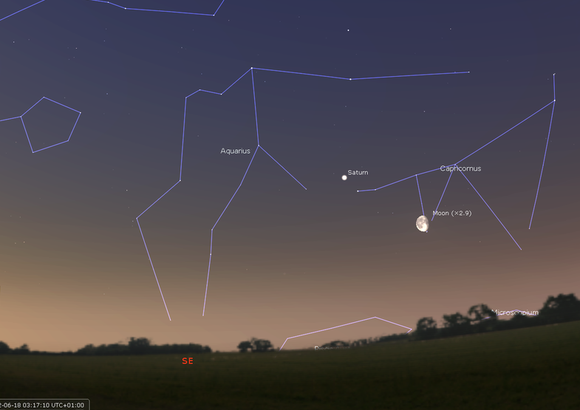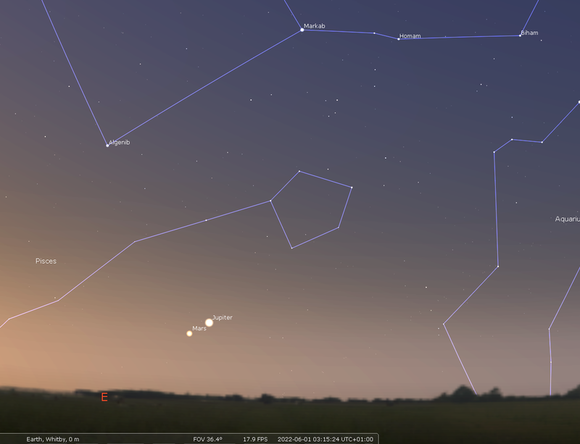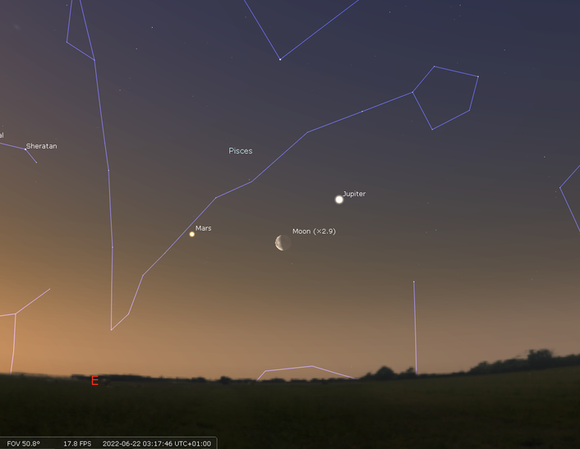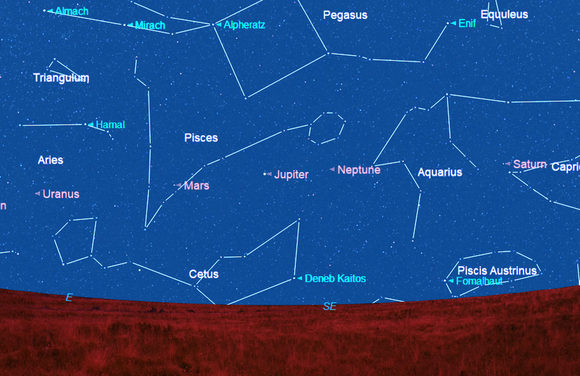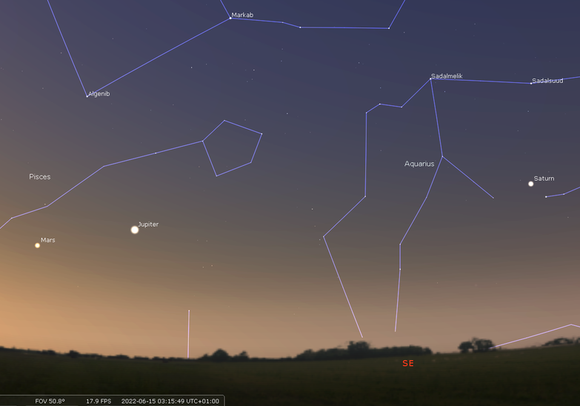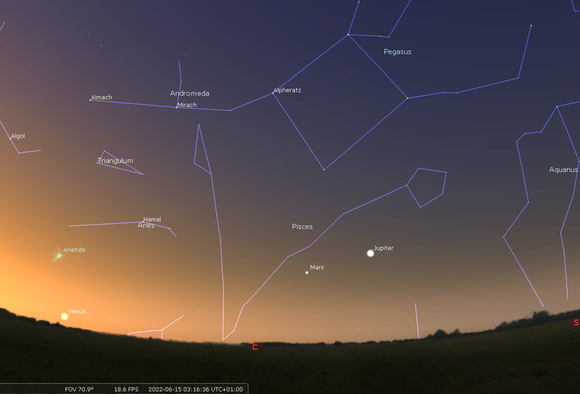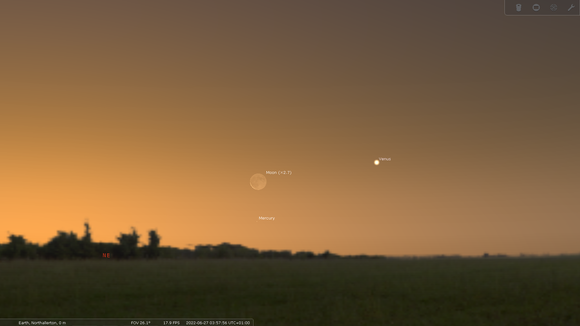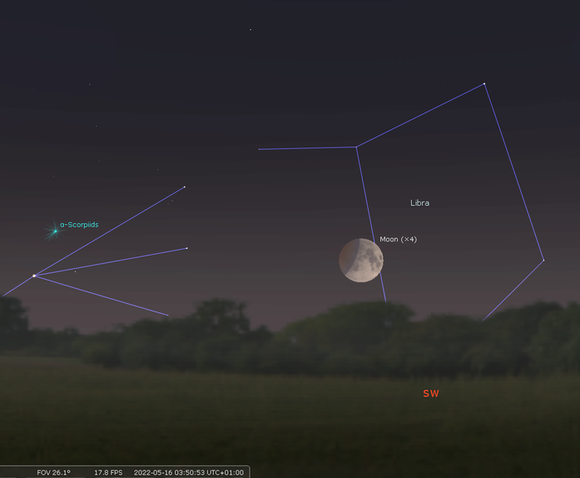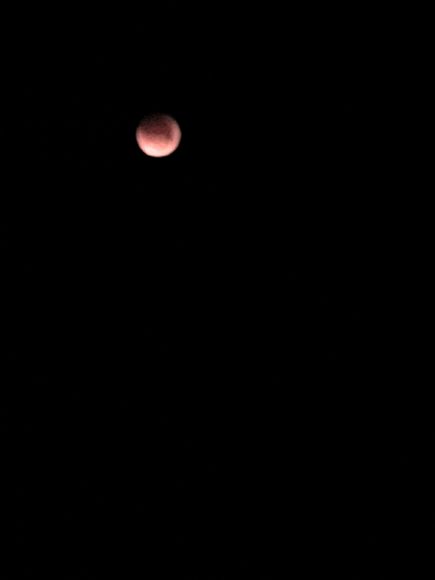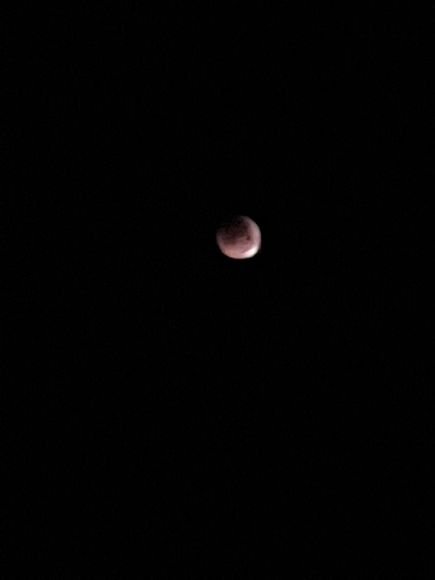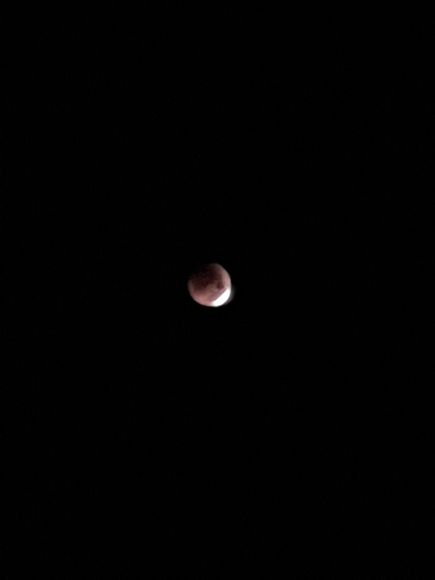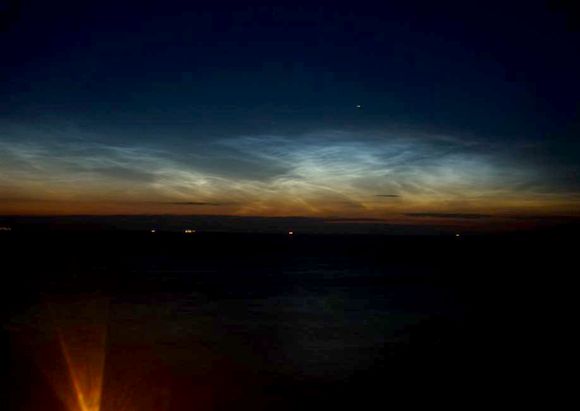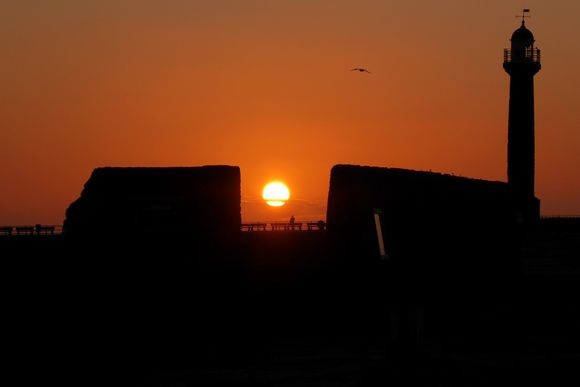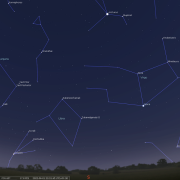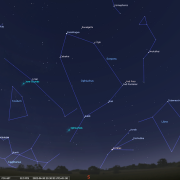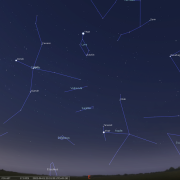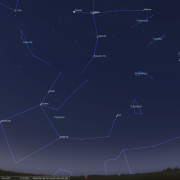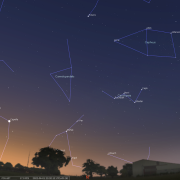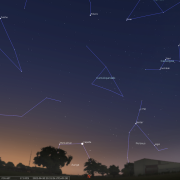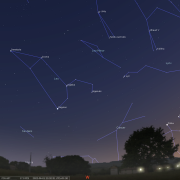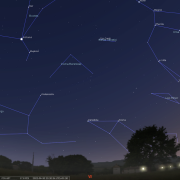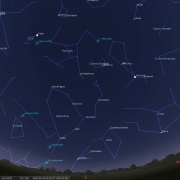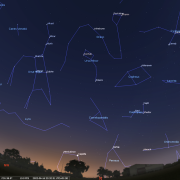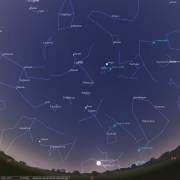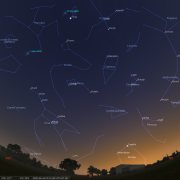In this month's Sky Notes:
- Planetary Skylights
- Lunar Eclipse Sighting
- June meteors
- Noctilucent cloud season
- Summer solstice
- June Night sky in brief
- June 2022 Sky Charts
Planetary Skylights - Brief
Always a challenging month for nocturnal observations, June could be regarded as almost a 'lost month' for observations of a planetary nature this year, arranged in the sky as they are. Indeed planets are void from the evening twilight sky completely, being reserved for post midnight - predawn hours only. Here you will locate (with some willing effort) Jupiter, Mars, Saturn, Venus and technically, Mercury too! Willing, because you have to be pretty dedicated to view them at all, either that, or be in a position to do so without drastically changing sleep patterns.
For example from the latitude of Whitby (roughly 54.5 degrees N) by mid June Saturn becomes apparent to the naked eye by 01:00hrs, with Jupiter and Mars following around an hour later and Venus an hour after that! By 04:00hrs twilight conditions are virtually too light to observe them, allowing barely a 3 hour window. Live further north and this window is almost closed. Matters improve only marginally by the month's end, with the planets rising 45 minutes earlier, but dawn's early light still arriving at 04:15 am. That said there is almost something mystical in being able to spot the early morning planetary cavalcade before daylight robs the opportunity to do so, you just need a bit of willpower to do so.
Pre-Dawn Planets
 Saturn is first of the 'dawn' planets to ‘show face’, locate it low in the SE sky by 02:00hrs as June commences and shortly after midnight by the months end. At magnitude +0.6 Saturn will be reasonably prominent, a pearly white presence over in the sparsely populated SE aspect. Unless you have very powerful and mounted binoculars, a telescope is required to view the wonderful rings of Saturn, however the image will be somewhat compromised from the UK by poorer seeing conditions that exist at lower elevations, that said, early morning air is usually more stable than in the evening and Saturn's elevation by the end of June will be a half respectable 21 degrees, so it may be worth sneaking an early peek at those rings. The waning moon sits lower right on June 18th @ 03:15hrs.
Saturn is first of the 'dawn' planets to ‘show face’, locate it low in the SE sky by 02:00hrs as June commences and shortly after midnight by the months end. At magnitude +0.6 Saturn will be reasonably prominent, a pearly white presence over in the sparsely populated SE aspect. Unless you have very powerful and mounted binoculars, a telescope is required to view the wonderful rings of Saturn, however the image will be somewhat compromised from the UK by poorer seeing conditions that exist at lower elevations, that said, early morning air is usually more stable than in the evening and Saturn's elevation by the end of June will be a half respectable 21 degrees, so it may be worth sneaking an early peek at those rings. The waning moon sits lower right on June 18th @ 03:15hrs.

 The month commences with Jupiter and Mars still close together in the sky, but they soon go their separate ways with Jupiter moving toward the SE. At magnitude -2.2, Jupiter will be far more conspicuous than Mars at magnitude +0.4, although Mars is very slowly improving. Telescopically, Mars remains a tiny orange 'let down' for most telescopes, although instruments of 12inch - 350mm plus may reveal more than just bland dot. Jupiter on the other hand is always a telescopic favourite - given the right circumstances, which June does not really afford, but there is no harm in trying if madness prevails. Both planets rise around 02:30hrs due east at the start of June with Jupiter visible by 01:15hrs by the month’s end in the ESE. Mars is apparent 30 minutes after Jupiter. View on June 22nd @ 03:15 when the waning Moon lies below and midway between them.
The month commences with Jupiter and Mars still close together in the sky, but they soon go their separate ways with Jupiter moving toward the SE. At magnitude -2.2, Jupiter will be far more conspicuous than Mars at magnitude +0.4, although Mars is very slowly improving. Telescopically, Mars remains a tiny orange 'let down' for most telescopes, although instruments of 12inch - 350mm plus may reveal more than just bland dot. Jupiter on the other hand is always a telescopic favourite - given the right circumstances, which June does not really afford, but there is no harm in trying if madness prevails. Both planets rise around 02:30hrs due east at the start of June with Jupiter visible by 01:15hrs by the month’s end in the ESE. Mars is apparent 30 minutes after Jupiter. View on June 22nd @ 03:15 when the waning Moon lies below and midway between them.
June is an odd month this year, with no planets visible in the evening sky and all in the pre-dawn sky. You will admittedly struggle to pick out Uranus and Neptune - but all five naked eye planets are on show. All that is required is a good flat horizon, clear skies down to said horizon and impeccable timing ie- just at the right time - around 03:55hrs. The last week of June is the best time to capture all five – although Mercury will be tricky.
June 26th - 03:55hrs. All five naked eye planets visible in pre dawn sky -
with Uranus and Neptune hiding in the twilight (click for full image)
The Moon passes by all the planets in turn from mid-month onwards.
 Venus (the morning star) is by far the brightest planet visible in the morning sky, but rises less than an hour before sunrise. At magnitude - 4.2 it is readily visible, but does require a clear ENE horizon, otherwise it will remain hidden. If you can train a scope on Venus, the view is not particularly awe inspiring, pretty much featureless, but at least you may be able to discern a phase - currently half. If possible view on June 26th @ 03:15hrs when a crescent moon lies immediately above Venus and just below the lovely Pleiades star cluster. Venus spends June drifting more toward the NE parallel to the horizon, but never really attains any further elevation.
Venus (the morning star) is by far the brightest planet visible in the morning sky, but rises less than an hour before sunrise. At magnitude - 4.2 it is readily visible, but does require a clear ENE horizon, otherwise it will remain hidden. If you can train a scope on Venus, the view is not particularly awe inspiring, pretty much featureless, but at least you may be able to discern a phase - currently half. If possible view on June 26th @ 03:15hrs when a crescent moon lies immediately above Venus and just below the lovely Pleiades star cluster. Venus spends June drifting more toward the NE parallel to the horizon, but never really attains any further elevation.
June 26 2022 @ 03:20hrs: a pleasing view of Venus, crescent moon and the Pleiades
(Click for full view)
 Technically Mercury is also visible in the dawn sky, but the apparition in June is very challenging for UK observers, Mercury barely reaching a couple of degrees above the NE horizon and 'viewable' for less than half an hour only. Should skies be clear and you want to take on the challenge, view during the last week of the month and in particular 03:40hrs on June 27th looking ENE. Mercury will lie just above the horizon with the slenderest of a crescent moon above - a challenge in itself!
Technically Mercury is also visible in the dawn sky, but the apparition in June is very challenging for UK observers, Mercury barely reaching a couple of degrees above the NE horizon and 'viewable' for less than half an hour only. Should skies be clear and you want to take on the challenge, view during the last week of the month and in particular 03:40hrs on June 27th looking ENE. Mercury will lie just above the horizon with the slenderest of a crescent moon above - a challenge in itself!
Lunar Eclipse - May 16th. Sighting?
It looked like most parts of the UK were clouded out for the lunar eclipse on the morning of May 16th. The Moon would just have been entering totality as it reached the horizon and it would have been rather interesting to observe in the bright twilight. As things turned out, the early 04:00hrs alarm call was redundant, a 90% chance of heavy cloud cover and rain deterring nearly all from setting one. However, one society member did manage to view the eclipse, but not from the UK. Andi Ye, who is now based in Tenerife, set that alarm (actually don't think he really went to bed) and managed to capture a few hand held images on his phone of the moon in totality. Admittedly they are not great (as he himself acknowledged) but it is an image of the totality eclipsed moon and more than we managed back in the UK. From Tenerife the total eclipse could be enjoyed in its entirety, well above the horizon. So we do have a record of some sorts of the lunar eclipse - May 16th 2022.
The total lunar eclipse of May 16 2022 - 04:00hrs -
Image by Andi Ye From Tenerife
(click for larger image)
The total lunar eclipse of May 16 2022 - 04:00hrs.
Images by Andi Ye - From Tenerife
(click for larger image)
The total lunar eclipse of May 16 2022 - 04:00hrs.
Images by Andi Ye - From Tenerife
(click for larger image)
Meteor Watch - June

Meteor activity is rather sparse in June, with no well defined meteor showers of note to speak of. The low levels of observed activity are due to a number of reasons. The short, light nights certainly are one factor, but the trickle of low activity that is present chiefly comes from the ecliptic, which from the UK is low to south at this time of year. The minor showers that are apparent produce only a handful of meteors at best. The Ophiuchids, the radiant of which lies near Theta Ophiuchi - approximately 15 degrees east of Antares, may produce 5 or so per hour with peaks on June 9th and 19th. The Beta Taurids are associated with debris left by Comet P/Encke, but unfortunately the shower occurs during daylight hours over the course of June. Radio detection methods do seem to indicate the shower is one of the strongest 'radio meteor showers' of the year. The Alpha Cygnids yield just a few meteors per hour near the end of June. The radiant lies close to Deneb, which is at least high in the sky!
Noctilucent Cloud - June Peak
Although I personally have yet to view a display of Noctilucent cloud so far this year, June offers up the best chance in which to do so, with the height of the Noctilucent cloud season normally around the summer solstice. This rather beautiful type of cloud formation only forms during the early summer months and may only be seen above the northern horizon long after sunset, often around midnight. Its appearance is quite distinct, filamentary in structure, shining quite brightly and exhibiting a characteristic silvery-blue hue. It forms exclusively between latitudes 50 and 60 degrees north, at an altitude of over 50 miles, five times higher than normal clouds. The cloud forms when water vapour condenses at the low temperatures that prevail at such altitudes onto particles suspended in the air. If possible, keep an eye out to the north - you never know!
The Summer Solstice
The summer solstice in the northern hemisphere falls on June 21st this year, when the Sun reaches its greatest altitude in the sky on the ecliptic; the path it takes across the sky during a year. Solstice comes from the Latin words sol, meaning Sun and sistere, meaning to come to a stop or stand still. On the day of the June solstice, the Sun reaches its northernmost position, as seen from the Earth. At that moment, its zenith does not move north or south as during most other days of the year, but it stands still at the Tropic of Cancer. It then reverses its direction and starts moving south again. The opposite happens during the December solstice. Then, the Sun reaches its southernmost position in the sky corresponding to the Tropic of Capricorn, standing still before reverses its direction towards the north.
It is often wrongly assumed that Earth lies closer to the Sun at this time of year; in fact the opposite is true. Earth is actually furthest from the Sun on July 4th at almost 95 million miles, nearly 3 million miles more than when at its closest approach in early January. It is the inclination of the northern hemisphere towards the sun which causes days to feel warmer due to the higher concentration of sunlight per unit area. Think of this as being like a spot light directed onto to the palm of your hand, your palm feels hotter under direct radiation, whereas when the light is tilted, the angle reduces the heat intensity. The actual intensity of solar radiation in June is equivalent to approximately 1.2KW of heat for each square metre on the surface!
The position of the summer solstice currently stands on the Gemini-Taurus constellation border but it wasn’t always so. Thousands of years ago this position stood before the stars of Cancer in the northern hemisphere, but has subsequently shifted due of the effects of precession, Earth’s slow axial wobble. From our latitude we never see the Sun overhead, however anywhere between latitude 23.5 degrees North, and latitude 23.5 degrees South, the Sun can appear directly overhead, casting no shadows, a phenomena astronomers in antiquity duly noted. Because the summer solstice then stood before the stars of the constellation Cancer, the latitude of 23.5 degrees north eventually became known as the tropic of Cancer. Similarly, the Sun then stood before the stars of Capricorn when at its southern limit on the ecliptic (the winter solstice) 23.5 degrees south of the celestial equator and the origin of the tropic of Capricorn.
Astronomers and scientists use the date of the June solstice to mark the beginning of summer in the Northern Hemisphere, for meteorologists, on the other hand, summer began almost three weeks earlier on June 1. Although known as the longest day, earliest sunrise and latest sunset times do not occur on the summer solstice date. From Whitby earliest sunrise falls around June 16th at 04:25hrs, whilst latest sunset occurs on June 25th at 21:42hrs. It is the duration of useable daylight which reaches a maximum on the 21st, which from Whitby is just over 17 hours, leaving a meagre 4 hours of semi darkness. Considered by most people as the date of the June solstice, the 21st is not the only date it can happen. In fact the summer solstice can fall anytime between June 20 and June 22. June 22 solstices are rare - the last one took place in 1975 and there won't be another one until 2203!
June Night Sky - in Brief
The short nights in summer make ‘deep sky’ observations of the heavens nigh on impossible, confined to a couple of hour’s post midnight and reserved for the dedicated amateur. Casual ‘stargazing’ – otherwise known as stellar identification, may be practised by anyone out for a stroll under the summer canopy. For those who like to note the bright luminaries sprinkled across the late evening summer sky, first look high to the east where sparkling steely blue Vega catches the eye in the small constellation of Lyra. Although not quite the brightest star visible in the summer night sky, it is normally first to appear and is certainly the most brilliant member of the ‘summer triangle’ and a striking sight in binoculars or a telescope. Vega resides approximately 26 light years distant and although believed to be only 450 million years old is already halfway through its lifespan, being twice as massive as our sun.
The brightest summer star; Arcturus, can be located high in the SSW in the constellation of Bootes, but the slightly brighter skies in that direction mean Arcturus is normally second out after Vega. Arcturus is classed as an orange giant, a billion years further down the stellar evolutionary path than our Sun. It is approximately 37 light years distant and has one of the largest proper motions (genuine stellar movement) through space of any bright star so that in less than half a million years binoculars will be required to spot it at all! As large as Arcturus maybe, it would be dwarfed by a bright star visible very low above the SSW horizon. Antares, is the chief star in Scorpius, one constellation that actually does resemble the creature it represents, a pity then that from the UK only the upper half is visible. Antares is classed a red super giant star some 360 million miles in diameter. It is over 300 light-years distant.
Midway up in the SE, the most southerly member of the ‘summer triangle’- Altair, may be located in Aquila the Eagle, Altair also happens to be the nearest of the bright summer luminaries visible from our shores, a mere 16 light years away. One of the few popular Chinese tales associated with bright stars involves Vega and Altair; the imperial weaver girl and the lowly goat herder. The two fell in love and neglected their duties and so to prevent further interruption to their work the celestial emperor harshly separated them, placing them on opposite sides of the Milky Way. Thereafter, the couple were allowed only to meet on one night each summer, on the seventh night after the seventh full moon when magpies bridged the Milky Way with their wings.
Turn to the north to locate conspicuous Capella in Auriga, often mistaken for the North Star during summer months. It just so happens that this circumpolar winter star lies in that direction as it wheels around the pole. The true pole or North Star (Polaris) resides higher up in the north and is much less prominent, but can be tracked down using the ‘pointer’ stars in the bowl of the ‘plough’ or ‘big dipper’ asterism in Ursa Major located high to the NW. Finally, look east of Vega, for the third and least brilliant member of the summer triangle; Deneb, in the constellation of Cygnus. Deneb is ranked 19th brightest star in the sky, but its immense distance; around 1700 light years, masks Deneb’s real luminosity, perhaps 80-100 thousand times more than our Sun. After a relatively short life span - less than 20 million years, Deneb will grow to become a vast super giant star, before ending its days in cataclysmic fashion - as a supernova!
June 2022 Sky Charts
|
June 1st, south @ 23:00hrs
|
June 30th, south @ 23:30hrs |
|
June 1st, east @ 23:00hrs |
June 30th, east @ 23:30hrs |
|
June 1st, north @ 23:00hrs |
June 30th, north @ 23:30hrs |
|
June 1st, west @ 23:00hrs |
June 30th, west @ 23:30hrs |
|
June 16th, south aspect @ 23:00hrs |
June 16th, north aspect @ 23:00hrs |
|
June 16th, south aspect @ 03:00hrs |
June 16th, north aspect @ 03:00hrs |
All times BST - British Summer Time
Additional Image Credits:
- Planets and Comets where not otherwise mentioned: NASA
- Sky Charts: Stellarium Software and Starry Night Pro Plus 8
- Log in to post comments

